Soccer drills for technique passing
Organisation:
On 2 or 3 fields play 4:4, 3:3 or 2:2.
Encourage shooting from distance.
Points of attention:
Technical execution of the kick with the inside of the foot
: Stand leg; point in the direction of play; bent at the hip, knee and ankle.
Playing leg; turned outward; knee and ankle bent.
Playing foot; perpendicular to the direction of play; sole of the foot parallel to the ground; toes raised;
no weak ankleon the
kick.
A controlled swinging movement.
Technical execution of the kick with the inside of the instep
:Stand leg; 2 to 3 foot widths next to the ball; bent at the knee.
Tackle; on the inside of the spot where the laces begin.
Approach from an angle of approximately 45º.
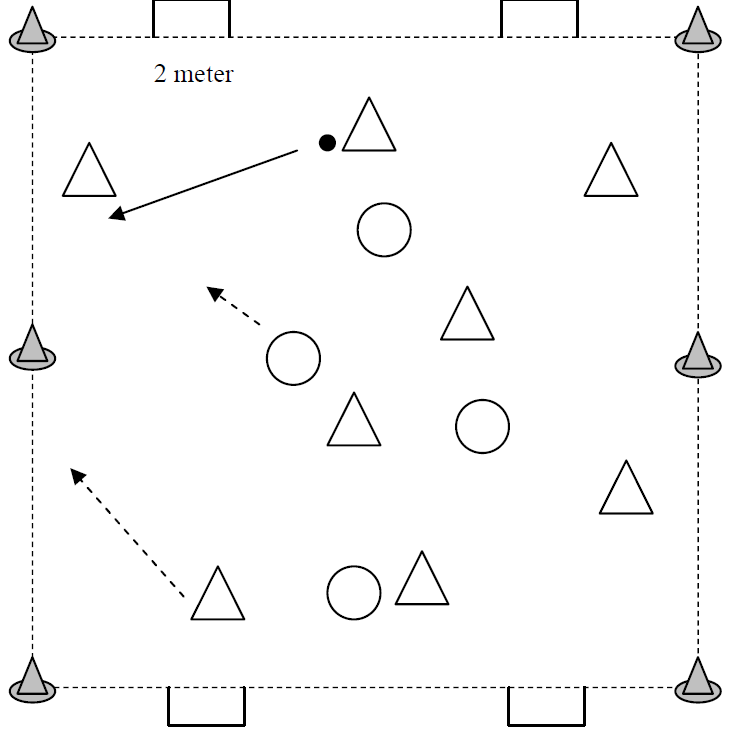
Organisation:
The game will be played 8:4.
6:3, 7:3, 7:4, 9:4 or 9:5 is also possible.
With more or less players the size has to be adjusted.
The 8-team may score after 5 replays.
The 4-player team may always try to score.
When the ball is intercepted by the foursome, when it goes out or after a goal has been scored, a new count must be made.
count again.
After, in total, 5 goals or after 10 minutes substitute.
To make it easier or more difficult, the number of replays can be changed.
Points of attention:
Use the left and right foot.
If possible, keep the ball low
.
Correct ball speed.
Play directly.
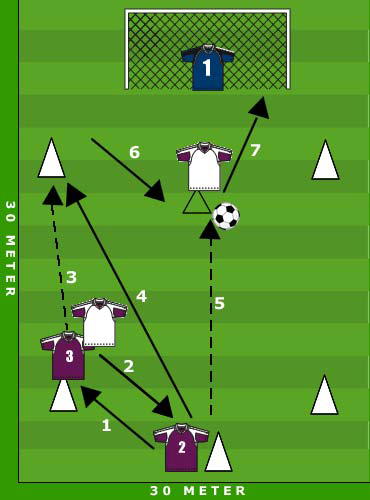
Field position:
1 starting pawn at 30 meters from the goal. A defender at 10 meters from the goal. A goalkeeper on the goal. A second defender with the rising attacker.
Sequence of play:
According to the numbering in the diagram, the pass from the attacker through the midfielder is played deep. The defender runs with the attacker while the midfielder runs towards the goalkeeper to get the ball there and tries to score.
Rules/tips:
- Defenders start at 50% effort and increase it later.
- Make sure the ball is played deep.
- The cross can be hit from the left or from the right.
- A variation on this is to play with 2 midfielders and have 1 run towards the far post.
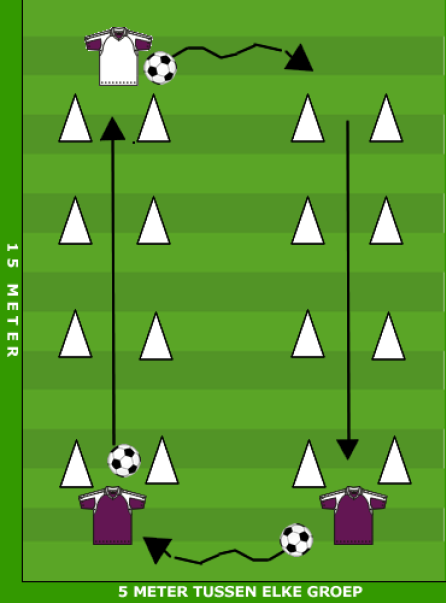
Field position:
Line up 2 x 4 x 2 pawns side by side to create two streets of pawns.
How to play:
Players must try to pass exactly through the street of pawns and then sprint through it chasing the ball. Another player (white) receives the ball and dribbles to the other street. There this player does exactly the same towards player 3.
Player 3 starts again on the same spot as player 1.
Rules of play:
- The ball must go through the street of pawns.
- If you hit a pawn, you must sprint to set it straight and try again.
- The ball must pass all cones before the receiving player can receive it.
Field setup:
Line up 2 Pawns per player group opposite each other with starting 5 meters in between. Later this can be extended to 10 or 15 metres.
How the game progresses:
The players must try to knock over each other's cone.
Rules of the game:
- You are not allowed to stand in front of your cone but must always stand behind it.
- When you shoot, you can put the ball on the left or the right side of the cone.
- If you hit the cone you get 1 point.
- When the trainer whistles you have to change with another player.
- You may not stand opposite the same player.
- Ordinary rules of the game (match alike)
- Check that what has been learnt is understood and applied in a game
- Scoring in the small goal must be done with the foot. = 1 point
- Scoring in the big goal with the head = 2 points
- Has the objective been achieved?
- To see the relationship between the solutions/possibilities offered in the previous exercise forms and the party form (competition)
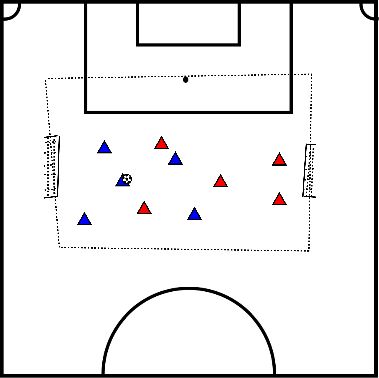
- Upper exercise:
- No. 2/5 has the ball.
- One of these two starts with the ball and plays in number 6.
- Number 6 bounces the ball back to number 2, number 10 in the meantime, together with number 7, make their move.
- Number two plays in number 10.
- Number 10 plays the ball deep on number 2.
- Number 2 takes the ball at the foot.
- Number 7 and 9 position themselves in front of the goal while number 2 brings the ball forward.
- Bottom exercise:
- Number 6 and 8 take turns playing the ball to number 10.
- Number 8, for example, plays to number 10.
- Number 10 bounces the ball to number 6.
- Number 6 plays the ball closely in front of number 2.
- Number 2 bounces the ball to number 7, which has entered for action as soon as number two starts running.
- Number plays the ball and the depth for number two.
- Number 7, 9, 11 make their run action towards the goal.
- Number 10 stands on the 16-metre line in front of the falling ball.
Switching positions:
- Number 6 8 and 10 switch positions. The player inserting the ball lands on the position of the player playing the ball deep for No. 2 or No. 5.
- The player playing the ball deep substitutes number 10.
- No. 10 stands behind one of the two with the least number of people.
- Numbers 7 and 2 alternate positions.
- Numbers 5 and 11 alternate positions.
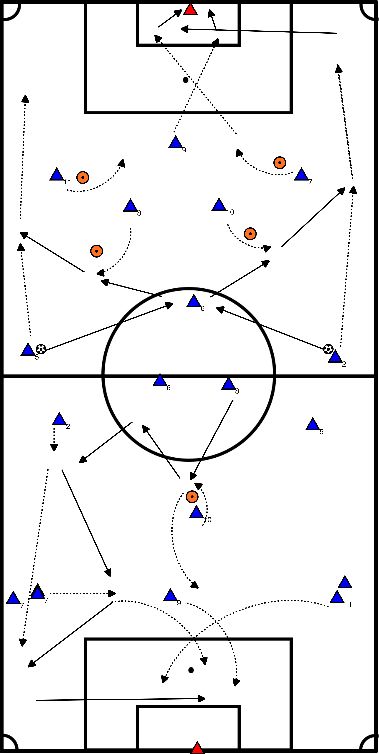
- Defence to attack in a 1-4-4-2.
- The running forms of the attack and defence are important here.
- Form two of the two where the focus is on the outfielder 7/8 creates space for the 2/5 .
- Here the six of the bb game is used to give the through ball.
- The exercise can be done without or with resistance.
- In the case of the ball owning party it is important that they do not play the ball directly on the 7/8 but first move the ball for some time between 3->4 4->5, where five gets up high as soon as the ball goes from two to three.
- When five receives the ball do not play directly to the eight but first back to the four.
- From four to three and from three to two.
- Allow the defence to pass the right running lines at the right time before they play the ball to the 7/8.
- As soon as the ball goes from the two to the seven, pay attention to the correct running lines of the seven.
- Creating space for the two is done by letting the seven get into the ball and bouncing the ball to the six.
- After bouncing from the two to the seven the two has to make a run in the deep.
- The seven bounces the ball onto the six that comes under the ball.
- The six then plays the ball deep on the two with the nine running to the first post, the eleven behind the nine and the eight around the second post in an oblique line behind the eleven and nine.
- Ten comes on the sixteen-metre line and the seven diagonally behind the two.
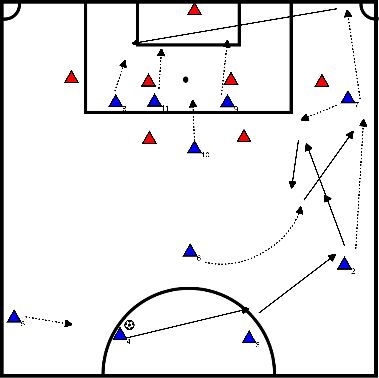
- Player passes the ball to the striker.
- Striker bounces the ball back
- A player plays the ball deep into the corner.
- The Third Player sprints in that direction and passes the ball in front.
- The first player is sprinting along and finishes on the goal.
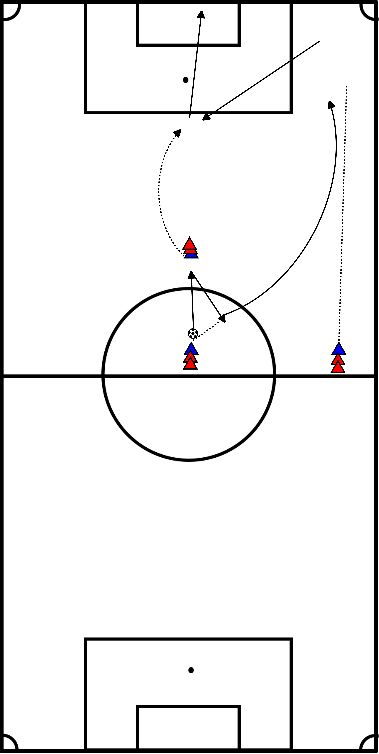
- Pairs of two
- one of them passes the ball and the other bounces it back.
- the bouncing player runs back and forth between a pilon and a the spot of bouncing.
- challenge is to play as much good bouncing balls as possible in 45 seconds.
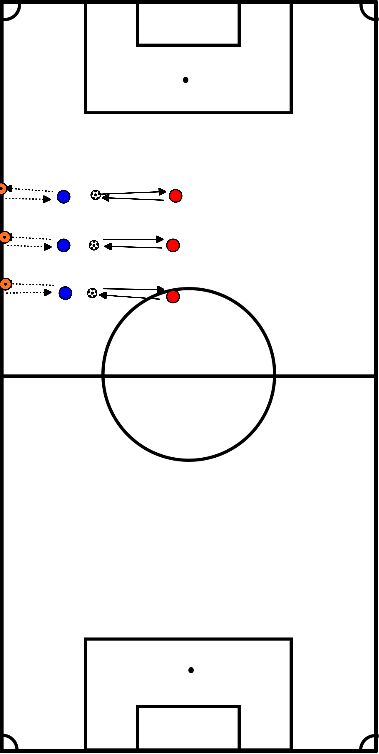
- The defenders (formation 1-2-2) try to prevent the attackers from scoring, by making the space as small as possible and conquering or blocking the ball at all costs.
- The defenders help each other by keeping the distance between them as small as possible.
- The attackers (formation 4-2) try to make the field as large as possible in order to score a goal
- After conquering the ball, the defenders can try to score in a small goal
- The attackers can score in a big goal with a goalkeeper
- When the ball goes out of the field, it is kicked back in where it went out.
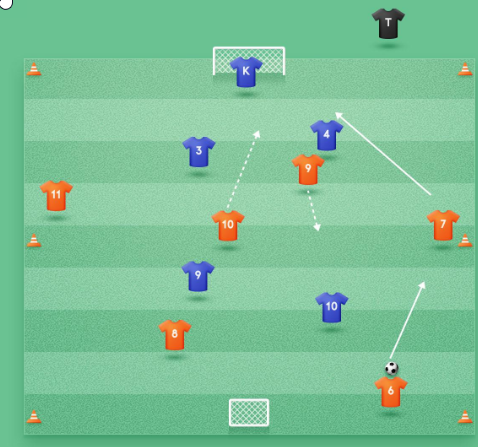
- In this exercise, an attacker is played by a midfielder while he has a defender behind him.
- The attacker must hold the ball for 5 seconds so that the midfielder can close in and receive the ball.
- The defender must try to take the ball.








